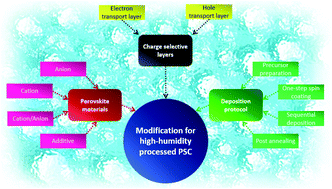High-humidity processed perovskite solar cells
Abstract
Perovskite solar cells (PSCs) are considered the next-in-line technology in the solar industry. This technology can reduce the cost of solar energy to an unprecedented level given their remarkably high efficiency and ease of manufacturing. Hitherto, many studies have preferred well-regulated inert conditions or a low-humidity atmosphere (relative humidity < 30%) for fabricating highly efficient PSCs to avoid the adverse impact of humidity on a perovskite film. This is because humidity is the main reason for perovskite instability and can alter the film growth kinetics during the fabrication process, thereby ultimately affecting the morphology of the grown film and the device performance. The requirement for an inert or low-humidity environment can increase the capital costs of setting up the fabrication facilities and hamper the large-scale production of PSCs. Therefore, efforts have been devoted to preparing PSC devices in a high-humidity environment to comprehend perovskite crystal growth kinetics and improve the morphological properties and stability of the perovskite film. This review highlights the modifications implemented towards (1) perovskite materials, (2) charge-selective layers, and (3) deposition protocols by spin-coating, to adapt a high-humidity atmosphere (RH ≥ 30%) for developing efficient PSCs. The progress of scalable processing methods such as blade-coating, inkjet printing, slot-die coating, and spray-coating, and the translation of spin-coating-modified protocols into these methods are also discussed. Finally, this review provides the remaining challenges to realizing the high-humidity fabrication of PSCs for commercialization.



 Please wait while we load your content...
Please wait while we load your content...